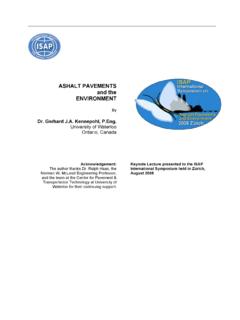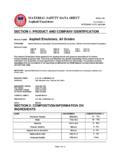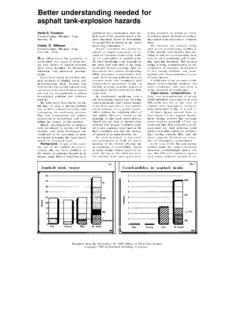Transcription of Insights into Binder Chemistry, Microstructure, Properties ...
1 Insights into Binder Chemistry, Microstructure, Properties Relationships - Usage in the Real World Jean-Pascal Planche, PHD June 1 5, 2014 Raleigh, North Carolina, USA 1 Outline Background - Context Chemical-physical and structural Properties of asphalt Impact on asphalt mechanical Properties asphalt modification Impact on structure and mechanical Properties Summary Perspectives 2 Context asphalt binders behavior dependency Crude oil origin and process Temperature and time dependency of molecular interactions and asphalt structure Aging impact Chemical Oxidation Plant and in-service aging Physical aging testing and in-service Additives chemistry / physical Properties and their interactions / compatibility with asphalt
2 Importance of understanding the relationships between composition structure- Properties Refiner / asphalt Binder -additive supplier: crude selection / Binder formulation and process Applicator / contractor: mix design and application Owner: specification and pavement performance ? Background A challenge So much knowledge acquired, worldwide But so much unknown, still!.. Focus Some particular aspects of asphalt structure influence of additives Examples of some innovative Binder characterization methods Meaning of the results in the real world testing and performance Not meant to be exhaustive, but to reconnect some dots A long trip through history, present time the future?
3 My deepest acknowledgements to fine researchers / technologists: Anderson, Bahia, Brule, Claudy, D Angelo, Di Benedetto, Jones, King, Kluttz, Lapalu, Lesueur, Letoffe, Little, Mouillet, Schabron. Pauli, Petersen, Redelius, Rowe, Such, Turner, Youtcheff, .. WRI, TU Delft, Nottingham, ENTPE, KTH, IFFSTAR (LCPC), FHWA, and BP, Kraton Polymers, Nynas, Shell, Total (Elf).. Outline Background - Context Chemical-physical and structural Properties of asphalt Impact on asphalt mechanical Properties asphalt modification Impact on structure and mechanical Properties Summary Perspectives 5 asphalt chemical composition asphalt = a blend of complex hydrocarbons Viscous and black Complex composition = the chemistry supermarket!
4 Ten-Hundred Thousands of different molecules Polarity and aromatic continuum Associated species Elemental composition Carbon 83-87% Hydrogen 10-14% Heteroatoms: Sulfur, Oxygen, Nitrogen 1-9% Vanadium, Nickel, Iron 1-2000 ppm Specificities Hydrogen deficient hydrocarbons Ni/V and C/H sometimes used as crude oil or process tracers Refinery Block Diagram 7 Kerosene Crude Oil Vacuum Distillation asphalt CAS# 8052-42-4 Gasoline Gas Oil Solvent Deasphaltening Gas, propane, To other refinery units Atmospheric Distillation Fuel oils / heavy fuel oils asphalt Blowing Column Air Oxidised asphalt CAS#64742-93-4 Blender Specification Grade asphalt Atmospheric Residue 300-350 C 350-425 C 10-100mm Hg 230 - 260 C Vacuum residue CAS# 64741-56-6 After AI-Eurobitume document Complex asphalt production process (Europe-US) 8 Examples from the SHRP AMRL library Dependence on crude oil origin & process Only 10% all crude oils yield asphalt !
5 Generic fraction composition to overcome the complexity asphalt chemical composition asphalt N-Heptane Separation Soluble Insoluble / Precipitate ASPHALTENES MALTENES Elution Chromatography Toluene Aromatic Oils n-Heptane Toluene/Methanol Resins Generic fractions of asphalt Saturates Oils S A R A Saturates, Naphthenes Polars / Resins, Pericondensed Structures with Side Chains Asphaltenes: Pericondensed Aromatic Structures Aromatics Pre-coke Mesophase Adsorption Chromatography Fractions Maltenes / Petrolenes Subfractions Asphaltenes Precipitation / Solubility asphalt SARA separation in fractions of a continuum Fraction chemistry defined by the particular methods and/or solvents used Generic fractions of asphalt Heptane Toluene CH2Cl2.
6 MeOH Cyclohexane Resins-like More Aromatic Fewer Alkyl Side Chains Pre-Coke Aromaticity and Polarity Increase Some of the fractions consist of associated species 11 Asphaltenes are also part of the continuum Asphaltene subfractions can also be defined / separated according to their solubility in solvents Generic fractions of asphalt Light detector at 500 nm: Polycondensed Aromatics ELS detector: All Molecules Heptane CyC6 Toluene CH2Cl2 Toluene Heptane:Toluene 95:5 CH2Cl2 SAR-ADTM separates asphalt into 8 fractions Generic fractions of asphalt 13 Generic fractions of asphalt Asphalts & Heavy Oils separation by SAR-ADTM Rapid & Relevant analytical tool developed by WRI Whole product injected (2 mg) separated in 4hrs 4 separation columns Maltenes & varnish Polars/resins Saturates and aromatics Asphaltene subfractions Dual detection by ELSD and Light Repeated injections SAR-ADTM patented asphalt generic fractions Model molecules and structures asphalt Colloidal structure model Structural Model of asphalt Hypothesis.
7 asphalt molecules assembly in a colloidal structure temperature dependent SOL = Asphaltene micelles well peptized / dispersed in the maltene solvent matrix Low content in asphaltenes and saturates High content in aromatics and resins GEL = Asphaltene micelles poorly peptized High content in asphaltenes and saturates Low content in aromatics and resins At high temperature: homogeneous SOL structure Brownian relaxation above about 80C where interactions, polar, in asphaltenes and resins are destroyed Boussingault (1837), Nellensteyn (1923), Pfeiffer (1940), Yen, Storm, Pal-Rhodes, Lesueur (1996).
8 Revisited 16 0200400600800012345 Temps (min)Intensit Agglomerated Asphaltenes Dispersed Asphaltene Micelle Sol-Gel asphaltene molecular association (peak) evaluated by High speed SEC I ncrease during aging - Correlated with carbonyl and sulfoxide formation A sphalt source, additive and process dependant Works: Brule, Such (80 s), Jennings, Pribanic (90 s), Chailleux, Mouillet (2010 s) Structural Model of asphalt SOL/GEL Shell Model 17 Dispersed Polar Fluid Model Developed under SHRP - based on fluid polarity Asphalts: homogeneous concentrated mixtures of polar materials dispersed in neutral materials Polars in a continuous, rather homogeneous, 3-D network No asphaltene but a range of polar compounds - strong/weak acid/bases through amphoterics Oxidation effect: molecular species sensitive to oxidation, increase the polar content, the size and strength of the 3-D microstructure After.
9 Robertson et al Jones et al 18 Diagram of Titration of Venezuelan Bitumen By Redelius - Credit To Fuel 79 (2000) Black Squares = Precipitation Points 3D Solubility parameter A ccounts for various interactions between the various bitumen molecules H-Bond Polar Wan der waals D edicated to embrace solubility issues as a whole Dispersed Polar Fluid Model asphalt Compatibility 19 Compatibility concept - Operational Mixing similar materials gives expected results - linear rule - blending Consequently incompatibility is when mixing similar materials gives unexpected results - non-linear - like softer or stiffer than expected Ex.
10 Mixing incompatible asphaltenes from different asphalts (study from Anderson, Petersen) Compatibility: function of the maltene solvent power and the asphaltene dispersion (ref. Heithaus) Measured by Asphaltene Flocculation Titration Pa and Po peptizability of the asphaltenes and maltenes P- value: state of peptization of the asphalt (or the oil) asphalt Compatibility WRI method Automated Flocculation Titrimeter asphalt compatibility Consequences Colloidal structure parameters from SAR-AD, AFT, DSC and SEC can / could be used to assess compatibility, blending rules and aging effects Blends of various asphalt bases available in refineries Virgin asphalt and RAP or RAS blends Polymers / additives for asphalt modification Binder oxidative and physical aging No standard to identify the borderline between compatible and incompatible asphalt Example 1 - compatibility of SBS PMBs assessed using the instability index Gaestel index IC = (Saturates+Asphaltenes)/(Aromatics+Resin s) When IC increases, the colloidal stability decreases Rule of thumb.






